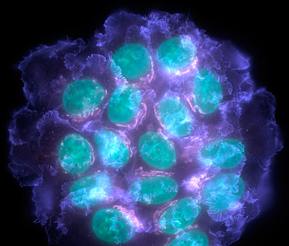 For the first time, scientists have discovered a way to predict whether women with the most common form of non-invasive breast cancer are at risk of developing more invasive tumors in later years. The women will then have the opportunity to be more selective about whether to choose radical treatments, according to the scientists.
For the first time, scientists have discovered a way to predict whether women with the most common form of non-invasive breast cancer are at risk of developing more invasive tumors in later years. The women will then have the opportunity to be more selective about whether to choose radical treatments, according to the scientists.
“Women will have much more information, so they can better know their risk of developing invasive cancer,’’ said lead author Karla Kerlikowske, MD. “It will lead to a more personalized approach to treatment. ”
“Women choose their treatment based on their level of concern of developing invasive cancer,’’ said Kerlikowske. As many as 44 percent of patients may not require any further treatment, such as chemotherapy or mastectomies, and can instead rely on surveillance.
(WATCH a video from KTVU San Francisco, or finish reading below)
The study was led by researchers at the University of California, San Francisco and the San Francisco Veterans Affairs Medical Center, and is reported online by the “Journal of the National Cancer Institute.’’
The authors followed the medical histories of 1,162 women aged 40 years and older who were diagnosed with the most common breast cancer — ductal carcinoma in situ (DCIS) — and treated with lumpectomies. They found two factors were predictors of risk of developing invasive cancer within eight years.
The study found that different combinations of biomarkers measured on the initial DCIS tissue, such as certain proteins, estrogen receptors and progesterone receptors, were associated with varying levels of risk of invasive cancer or DCIS.
Because of the research, physicians will now be able to predict whether a DCIS patient treated only with a lumpectomy will subsequently develop invasive cancer, or be at very low risk of developing further tumors, according to Kerlikowske, professor of medicine, and epidemiology and biostatistics at the UCSF Helen Diller Family Comprehensive Cancer Center, and co-director of the Women Veteran’s Comprehensive Health Center at SFVAMC.
Scientists have been trying to solve the DCIS problem for more than 20 years, said Kerlikowske, but until now have been unable to stratify women into risk groups.
“It is novel to be able to separate women into groups,’’ she said. “In the past, women were told they had a certain risk of developing further tumors, but could not be told whether they were at risk of an invasive cancer – risk of further tumors was lumped together into one risk group.’’
The data shows definite markers that will predict as far as eight years into the future, said Thea D. Tlsty, PhD, one of the principal investigators of the study. She is a professor of pathology and UCSF leader of the Cell Cycling and Signaling Program at the UCSF Helen Diller Family Comprehensive Cancer Center.
“This is an exciting and powerful beginning, to be able to predict which pre-cancers will lie dormant and which will lead to invasive cancers,’’ said Tlsty. “For the first time, we’ve identified that group of patients who have the lowest risk and the group at highest risk of developing invasive cancer. It’s a big step forward.’’
DCIS rarely leads to death from breast cancer – approximately 11 out of 100 women treated only by lumpectomy go on to develop invasive cancer within eight years of the initial diagnosis of DCIS, and only 1 to 2 percent of women die of breast cancer within 10 years of diagnosis. Yet, women diagnosed with DCIS have historically had an inaccurate perception of their risk of later developing invasive cancer, and as a result have chosen fairly aggressive courses of treatment, said Tlsty.
Currently, approximately 35 percent opt for a lumpectomy, about 25 percent for a complete mastectomy, 3 to 5 percent for active surveillance only, and the remainder for lumpectomy plus radiation or hormone treatment or both.
According to the study, the group of patients with the lowest risk has only a 2 percent chance of developing invasive cancer at 5 years and a 4 percent chance at 8 years.
“Now we are able to identify the group at highest risk of developing an invasive cancer,’’ said Tlsty. “Factors such as palpable DCIS and expression of protein levels of p16, cyclooxygenase-2 and Ki67 are found in approximately 50 percent of patients with DCIS who later develop invasive cancer. In collaboration with co-authors Hal Berman, MD, and Mona Gauthier, PhD, both faculty members of the Campbell Family Breast Cancer Research Institute in Toronto, Canada, we are identifying molecular markers that will stratify risk for the remaining patients.”



















